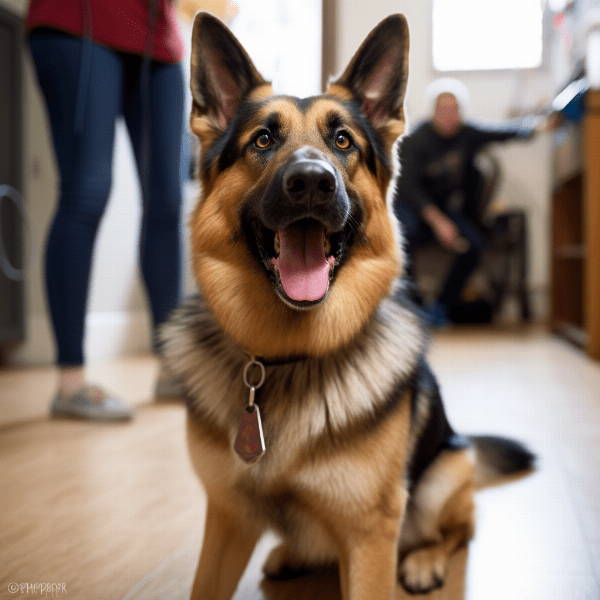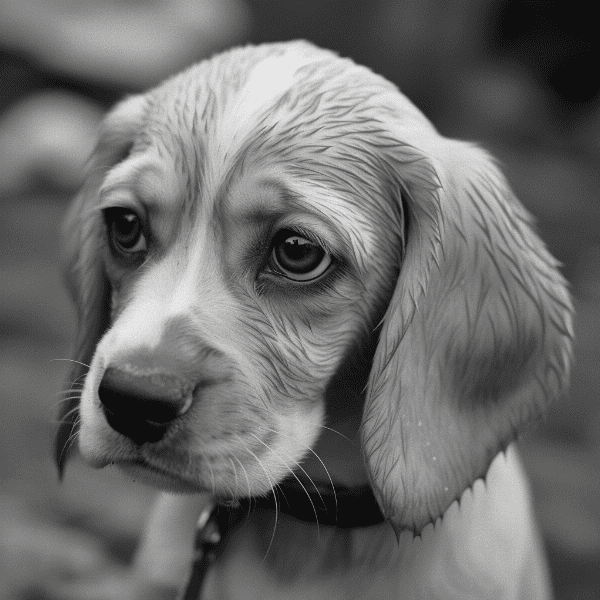Table of Contents
- Understanding Separation Anxiety in German Shepherds
- Signs and Symptoms of Separation Anxiety in German Shepherds
- Common Causes of Separation Anxiety in German Shepherds
- Training Techniques for Managing Separation Anxiety in German Shepherds
- Positive Reinforcement Strategies for Reducing Separation Anxiety
- Tools and Products to Help with Separation Anxiety in German Shepherds
- Creating a Safe and Comfortable Environment for Your German Shepherd
- Working with a Professional to Address Separation Anxiety
- Maintaining Consistency and Patience in Managing Separation Anxiety
- Celebrating Progress and Success in Overcoming Separation Anxiety.
Understanding Separation Anxiety in German Shepherds
Separation anxiety is a common behavioral issue that many German Shepherds experience when left alone for extended periods. This condition is characterized by excessive fear, anxiety, and distress when separated from their owners or primary caregivers.
The Nature of Separation Anxiety
German Shepherds are known to be highly social dogs that crave attention, affection, and companionship. As such, they are prone to developing separation anxiety when left alone for long periods. When these dogs experience separation anxiety, they may exhibit destructive behaviors such as chewing furniture, digging holes, and barking excessively. They may also display physical symptoms such as panting, trembling, and drooling.
The Impact of Separation Anxiety
Separation anxiety can have a significant impact on the mental and physical health of German Shepherds. Dogs that suffer from separation anxiety may experience elevated stress levels, which can lead to a range of health problems such as high blood pressure, obesity, and weakened immune systems. In addition, dogs with separation anxiety may become aggressive or develop other behavioral problems that can interfere with their quality of life.
Factors That Contribute to Separation Anxiety
There are several factors that can contribute to the development of separation anxiety in German Shepherds. One of the primary factors is a lack of socialization and training during the dog’s early years. Dogs that have not been exposed to a range of experiences and environments during their critical socialization period may be more prone to anxiety when left alone. Other factors that can contribute to separation anxiety include traumatic experiences, changes in the dog’s environment, and the dog’s genetic predisposition to anxiety.
Overall, it’s essential to understand that separation anxiety is a complex and challenging condition that requires patience, persistence, and a willingness to work with your German Shepherd to manage the condition effectively. By understanding the nature of separation anxiety and the factors that contribute to its development, you can take proactive steps to help your German Shepherd overcome their anxiety and lead a healthy, happy life.
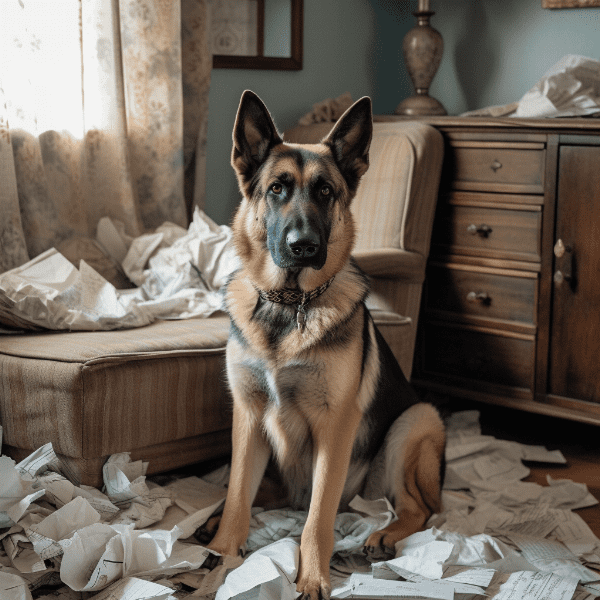
Signs and Symptoms of Separation Anxiety in German Shepherds
Separation anxiety in German Shepherds can manifest in a variety of ways, and it’s essential to be able to recognize the signs and symptoms so that you can take appropriate action. Here are some common signs that your German Shepherd may be suffering from separation anxiety:
Destructive Behavior
One of the most common signs of separation anxiety in German Shepherds is destructive behavior. Dogs with separation anxiety may chew furniture, dig holes, or scratch at doors and windows in an attempt to escape. This behavior is usually more severe when the dog is left alone for extended periods.
Excessive Vocalization
Another common sign of separation anxiety in German Shepherds is excessive vocalization. Dogs with separation anxiety may bark, howl, or whine excessively when left alone. This behavior is often accompanied by pacing or other signs of restlessness.
Physical Symptoms
Dogs with separation anxiety may also exhibit physical symptoms such as panting, trembling, and drooling. These symptoms are usually more severe when the dog is left alone for extended periods.
Inappropriate Elimination
Some German Shepherds with separation anxiety may also engage in inappropriate elimination. This can include urinating or defecating in the house, even if they are house trained.
Escape Attempts
Finally, dogs with separation anxiety may attempt to escape their confinement when left alone. This can lead to injury or damage to the home, and it’s essential to ensure that your dog is safely contained when you’re not home.
It’s important to note that these behaviors can also be indicative of other underlying medical or behavioral issues, so it’s important to consult with a veterinarian or professional dog trainer to rule out any other causes. If your German Shepherd exhibits these symptoms when left alone, it’s essential to work with a professional to develop a comprehensive plan to manage their separation anxiety effectively.
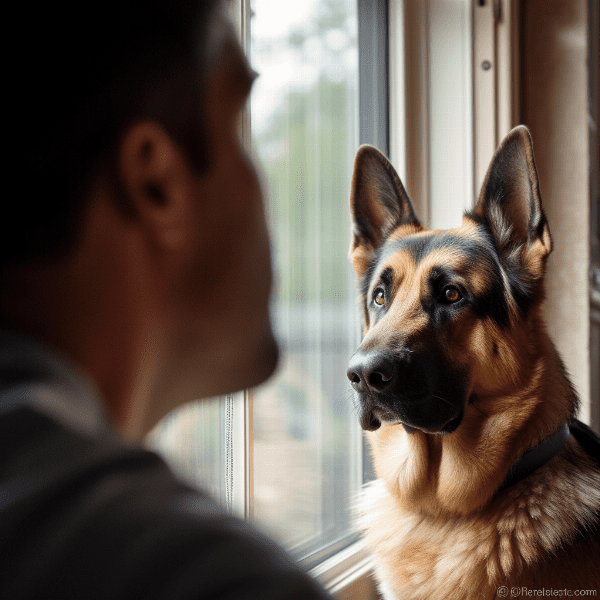
Common Causes of Separation Anxiety in German Shepherds
There are many reasons why German Shepherds may develop separation anxiety. Here are some of the most common causes:
Lack of Socialization and Training
German Shepherds that have not been adequately socialized and trained during their critical socialization period may be more prone to separation anxiety. Dogs that have not been exposed to different environments, people, and experiences may become fearful and anxious when left alone.
Traumatic Experiences
German Shepherds that have experienced traumatic events such as abuse, neglect, or abandonment may be more prone to separation anxiety. These experiences can leave a lasting impact on a dog’s mental health and make it challenging to cope with being alone.
Changes in the Dog’s Environment
Changes in the dog’s environment can also contribute to the development of separation anxiety. For example, moving to a new home, the loss of a family member or pet, or a change in the owner’s work schedule can be stressful for German Shepherds and make it challenging for them to cope with being alone.
Genetic Predisposition
Some German Shepherds may have a genetic predisposition to anxiety, which can make them more prone to developing separation anxiety. Dogs that come from lines with a history of anxiety or fearfulness may be more likely to develop separation anxiety.
Over-Attachment to Owners
Finally, German Shepherds that are over-attached to their owners or primary caregivers may be more prone to separation anxiety. Dogs that are used to constant attention and companionship may become anxious and distressed when left alone.
It’s important to note that there may be multiple factors contributing to the development of separation anxiety in German Shepherds. By working with a professional dog trainer or behaviorist, you can identify the root causes of your dog’s anxiety and develop a comprehensive plan to manage their condition effectively.

Training Techniques for Managing Separation Anxiety in German Shepherds
Managing separation anxiety in German Shepherds requires a multi-faceted approach that includes training techniques aimed at reducing anxiety and teaching the dog to cope with being alone. Here are some effective training techniques for managing separation anxiety in German Shepherds:
Gradual Desensitization
Gradual desensitization is a technique that involves gradually exposing your German Shepherd to being alone for longer periods. This technique involves starting with short periods of time and gradually increasing the duration over several weeks or months. It’s essential to pair this training with positive reinforcement to help your dog associate being alone with positive experiences.
Counter-Conditioning
Counter-conditioning is a technique that involves teaching your German Shepherd to associate being alone with positive experiences. This technique involves providing your dog with a special treat or toy that they only receive when they are alone. Over time, your dog will learn to associate being alone with positive experiences and may become less anxious when left alone.
Crate Training
Crate training can be an effective way to manage separation anxiety in German Shepherds. A crate can provide your dog with a safe and comfortable space to retreat to when you’re not home. However, it’s essential to ensure that your dog has positive associations with their crate and is not left in the crate for extended periods.
Positive Reinforcement Training
Positive reinforcement training is an effective technique for managing separation anxiety in German Shepherds. This technique involves rewarding your dog for calm and relaxed behavior when left alone. By providing positive reinforcement for desirable behaviors, you can help your dog learn to cope with being alone and reduce anxiety.
Managing separation anxiety in German Shepherds can be a challenging and time-consuming process, but with patience, persistence, and the right training techniques, it’s possible to help your dog lead a happy and healthy life. Working with a professional dog trainer or behaviorist can also be beneficial in developing an effective training plan for your German Shepherd.
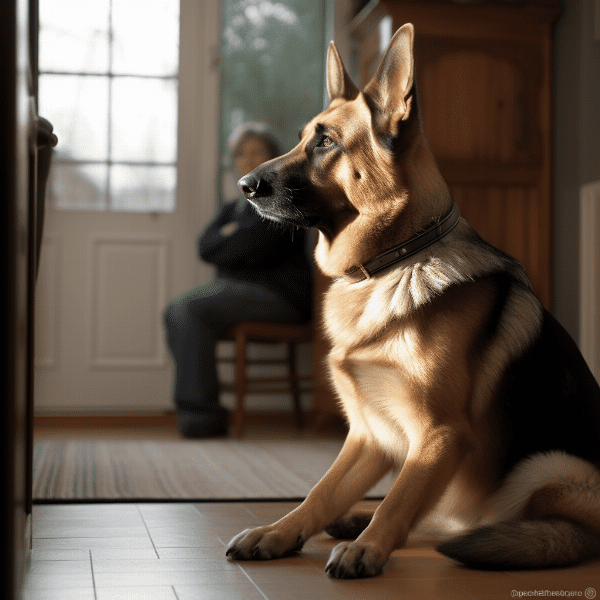
Positive Reinforcement Strategies for Reducing Separation Anxiety
Positive reinforcement is a powerful technique for managing separation anxiety in German Shepherds. This technique involves rewarding desirable behaviors and can help reduce anxiety and build confidence in your dog. Here are some effective positive reinforcement strategies for reducing separation anxiety:
Reward Calm and Relaxed Behavior
One of the most effective ways to reduce separation anxiety in German Shepherds is to reward calm and relaxed behavior when left alone. This can include rewarding your dog with treats or praise when they are calm and quiet in their crate or when they settle down after being left alone.
Create a Positive Association with Departures
It’s essential to create a positive association with departures to help reduce separation anxiety in German Shepherds. This can involve giving your dog a special treat or toy when you leave, so they associate your departure with a positive experience.
Gradually Increase Time Alone
Gradually increasing the amount of time your German Shepherd spends alone can also be an effective positive reinforcement strategy. By gradually increasing the time your dog spends alone and rewarding them for calm behavior, you can help build their confidence and reduce anxiety.
Use a Variety of Rewards
It’s important to use a variety of rewards when using positive reinforcement to reduce separation anxiety. This can include treats, toys, and praise. By using a variety of rewards, you can keep your dog engaged and motivated to continue exhibiting desirable behaviors.
Stay Consistent
Consistency is key when using positive reinforcement to manage separation anxiety in German Shepherds. It’s important to be consistent in your training approach and to reward desirable behaviors every time they occur. This will help reinforce good behavior and reduce anxiety over time.
Positive reinforcement is a powerful tool for managing separation anxiety in German Shepherds. By rewarding calm and relaxed behavior, creating positive associations with departures, gradually increasing time alone, using a variety of rewards, and staying consistent, you can help reduce anxiety and build confidence in your dog.

Tools and Products to Help with Separation Anxiety in German Shepherds
In addition to training techniques, there are several tools and products available that can help manage separation anxiety in German Shepherds. Here are some of the most effective tools and products:
Anxiety Wraps
Anxiety wraps, such as the Thundershirt, can help reduce anxiety in German Shepherds by applying gentle pressure to their body. This pressure can help soothe the nervous system and reduce stress and anxiety.
Calming Supplements
There are several natural calming supplements available that can help reduce anxiety in German Shepherds. These supplements may contain ingredients such as chamomile, valerian root, or L-theanine, which have calming properties.
Music and White Noise
Playing soothing music or white noise can help reduce anxiety in German Shepherds by creating a calming environment. These sounds can help drown out external noises and provide a sense of security and comfort.
Interactive Treat Toys
Interactive treat toys, such as KONG toys, can help keep German Shepherds entertained and distracted when left alone. These toys can provide mental stimulation and help reduce boredom and restlessness.
Pet Cameras
Pet cameras can help ease anxiety in owners by allowing them to check in on their German Shepherds when they’re not home. Some pet cameras also have two-way communication, which can help soothe anxious dogs by allowing owners to talk to them remotely.
Professional Dog Training
Working with a professional dog trainer or behaviorist can also be an effective tool for managing separation anxiety in German Shepherds. These professionals can provide guidance on training techniques, identify the root causes of your dog’s anxiety, and develop a comprehensive plan to manage their condition effectively.
It’s important to note that while tools and products can be helpful in managing separation anxiety, they should be used in conjunction with training techniques and under the guidance of a professional. With patience, persistence, and the right tools and products, it’s possible to help your German Shepherd overcome separation anxiety and lead a happy, healthy life.
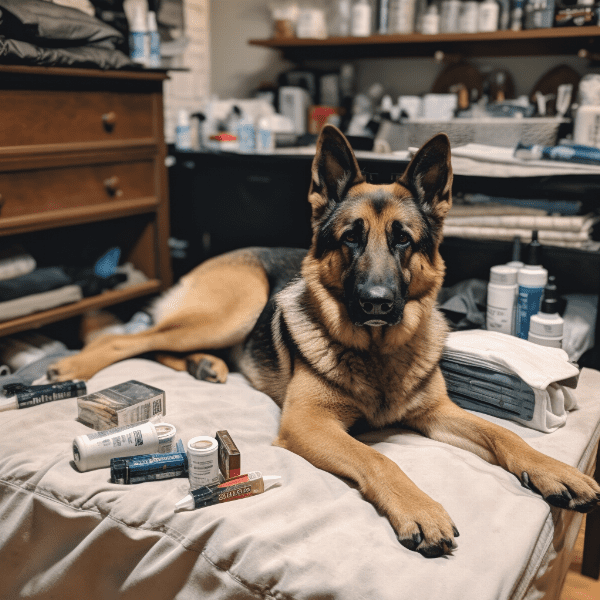
Creating a Safe and Comfortable Environment for Your German Shepherd
Creating a safe and comfortable environment is essential for managing separation anxiety in German Shepherds. Here are some tips for creating a secure and comfortable environment for your dog:
Provide a Comfortable Space
Providing your German Shepherd with a comfortable and secure space to retreat to when you’re not home can help reduce anxiety. This space can be a crate, a bed, or a designated area in your home. Make sure the space is comfortable and filled with familiar items such as blankets and toys.
Use Safe and Secure Containment
Using safe and secure containment is essential for managing separation anxiety in German Shepherds. This can involve using a crate or a secure gated area to keep your dog safe when you’re not home. It’s essential to ensure that the containment is safe and comfortable and that your dog has access to food, water, and a comfortable bed.
Keep Your Home Calm and Quiet
Keeping your home calm and quiet can also help reduce anxiety in German Shepherds. Loud noises, such as traffic or construction, can be overwhelming for dogs and may increase anxiety levels. It’s also essential to avoid sudden and unpredictable changes in the home environment, which can cause stress and anxiety in your dog.
Provide Mental and Physical Stimulation
Providing your German Shepherd with plenty of mental and physical stimulation can help reduce boredom and restlessness when left alone. This can include playing games, going for walks, and providing interactive toys and puzzles.
Keep a Consistent Routine
Keeping a consistent routine is essential for managing separation anxiety in German Shepherds. Dogs thrive on routine and predictability, and sudden changes can cause stress and anxiety. Keeping a consistent routine can help reduce anxiety and provide a sense of security for your dog.
By creating a safe and comfortable environment for your German Shepherd, you can help reduce separation anxiety and provide your dog with the security and comfort they need when you’re not home. With patience, persistence, and the right training techniques and tools, it’s possible to help your dog overcome separation anxiety and lead a happy, healthy life.

Working with a Professional to Address Separation Anxiety
If your German Shepherd is struggling with separation anxiety, it may be beneficial to work with a professional dog trainer or behaviorist. Here are some benefits of working with a professional to address separation anxiety:
Expert Guidance
Professional dog trainers and behaviorists have the expertise and experience to identify the root causes of your dog’s anxiety and develop a comprehensive plan to manage their condition effectively. They can provide personalized guidance and support, which can help improve the effectiveness of training techniques and tools.
Personalized Training Plan
Working with a professional can help you develop a personalized training plan that is tailored to your dog’s unique needs and personality. This plan can help address specific behaviors and provide a roadmap for managing separation anxiety effectively.
Access to Specialized Tools and Techniques
Professional dog trainers and behaviorists have access to specialized tools and techniques that can help manage separation anxiety effectively. They may be able to recommend specific products, such as anxiety wraps or calming supplements, or use specialized training techniques to help reduce anxiety and build confidence in your dog.
Support and Accountability
Working with a professional can provide support and accountability throughout the training process. They can provide guidance and feedback, which can help keep you on track and ensure that you are implementing training techniques and tools correctly.
Improved Outcomes
By working with a professional, you can improve the outcomes of managing separation anxiety in your German Shepherd. Professional guidance and support can help reduce the duration and severity of anxiety symptoms and improve your dog’s overall quality of life.
Overall, working with a professional dog trainer or behaviorist can be a valuable tool in managing separation anxiety in German Shepherds. With their expertise and experience, they can provide personalized guidance and support, develop a comprehensive training plan, recommend specialized tools and techniques, and improve the outcomes of managing separation anxiety.
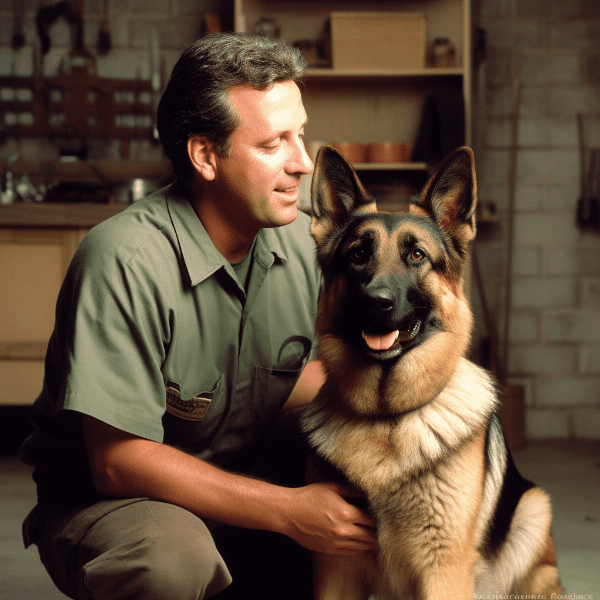
Maintaining Consistency and Patience in Managing Separation Anxiety
Managing separation anxiety in German Shepherds can be a challenging and time-consuming process that requires patience and consistency. Here are some tips for maintaining consistency and patience when managing separation anxiety:
Stick to a Consistent Routine
Consistency is key when managing separation anxiety in German Shepherds. It’s important to stick to a consistent routine and to avoid sudden and unpredictable changes. This can help reduce stress and anxiety in your dog and provide a sense of security and predictability.
Avoid Punishment
Punishment is not an effective tool for managing separation anxiety in German Shepherds. Punishment can cause fear and anxiety and may exacerbate the problem. Instead, it’s essential to focus on positive reinforcement and reward desirable behaviors.
Be Patient
Patience is essential when managing separation anxiety in German Shepherds. The process can take time, and it’s important to be patient and persistent in your training approach. It’s also important to recognize that progress may not always be linear and that setbacks may occur.
Seek Professional Help
If you’re struggling to manage your German Shepherd’s separation anxiety, it may be beneficial to seek professional help. Working with a professional dog trainer or behaviorist can provide guidance and support, which can help improve the effectiveness of training techniques and tools.
Managing separation anxiety in German Shepherds requires patience, consistency, and a multi-faceted approach that includes training techniques, tools, and a safe and comfortable environment. By setting realistic expectations, sticking to a consistent routine, avoiding punishment, being patient, and seeking professional help when needed, you can help your German Shepherd overcome separation anxiety and lead a happy and healthy life.
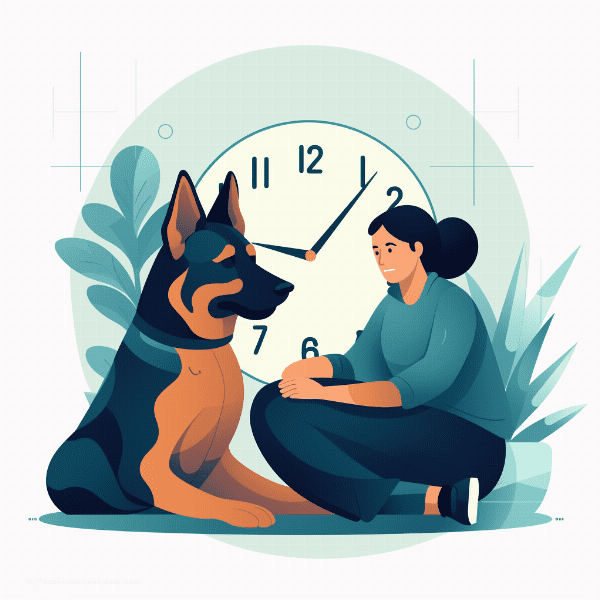
Celebrating Progress and Success in Overcoming Separation Anxiety.
Overcoming separation anxiety in German Shepherds can be a challenging journey that requires patience, persistence, and a multi-faceted approach. However, it’s important to celebrate progress and success along the way. Here are some tips for celebrating progress and success in overcoming separation anxiety:
Acknowledge Small Wins
Small wins can be just as important as big wins when managing separation anxiety in German Shepherds. It’s essential to acknowledge and celebrate even the smallest progress made by your dog, such as staying calm for a few minutes when left alone.
Set Achievable Goals
Setting achievable goals can help keep you motivated and celebrate progress along the way. It’s important to set realistic goals that are within reach and to celebrate when they are achieved.
Celebrate Milestones
Milestones, such as the first successful time left alone, can be a significant achievement in managing separation anxiety. Celebrating these milestones can help keep you motivated and recognize the progress that has been made.
Reward Desirable Behaviors
Rewarding desirable behaviors can be a powerful tool for managing separation anxiety and celebrating progress. It’s essential to reward your German Shepherd when they exhibit desirable behaviors, such as staying calm when left alone or settling down quickly when you return home.
Reflect on the Journey
Reflecting on the journey can also be an essential part of celebrating progress and success in managing separation anxiety. Taking the time to reflect on the progress made, the challenges overcome, and the lessons learned can help provide perspective and appreciation for the hard work and dedication that has gone into managing separation anxiety.
Managing separation anxiety in German Shepherds can be a challenging journey, but celebrating progress and success along the way can help keep you motivated and recognize the hard work and dedication that has gone into managing your dog’s condition. By acknowledging small wins, setting achievable goals, celebrating milestones, rewarding desirable behaviors, and reflecting on the journey, you can celebrate progress and success in overcoming separation anxiety.
